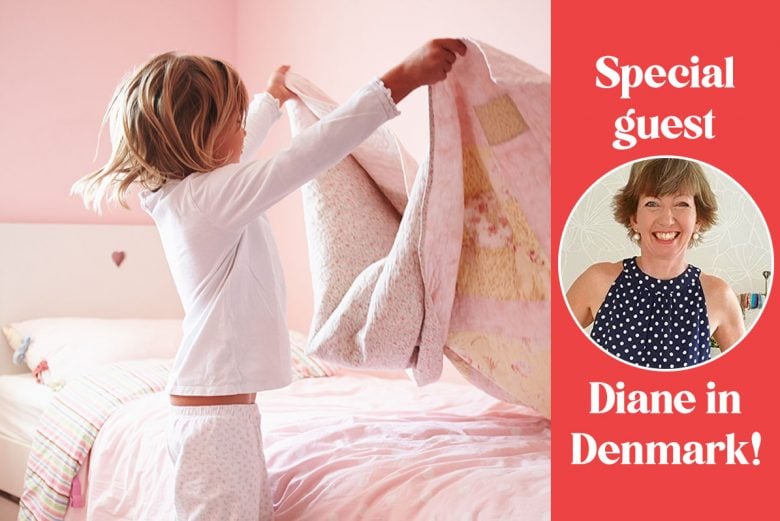
How to cut through the clutter without confining them
The Fun-loving Type 1 Child can sometimes have a reputation for being messy or cluttered. But that doesn’t have to be the case!
In this episode, Carol and Anne are joined by Diane in Denmark—a Type 1 who teaches other people how to be organized in their home and life. Her tips for Type 1 children will help them be organized while still honoring their light nature.
This episode’s Parenting Practice
Choose one of the tips from this episode and practice it, whether you’re a Type 1 yourself, or you have a Type 1 child that you parent. For more organizational tips and inspiration, visit Diane in Denmark’s YouTube channel.
Transcript of podcast episode
Carol: Welcome to The Child Whisperer Podcast. I’m your host, Carol Tuttle, author of the best-selling parenting book, The Child Whisperer. I’m with my co-host, Anne Tuttle Brown.
Welcome to this great series that I’m very excited about as well as Anne, who’s my co-host. We are going to be talking about life and space organization tips for each of the 4 Types of children. And this is the first podcast in this four podcast series, where we’re going to talk about the Type 1 child.
And I reached out to one of my good friends and actually she is a mentor of mine in many ways. She’s a very well-known YouTuber and she’s known for her teaching of routines and space and life management. She’s a coach and mentor. She’s a Type 1, and she’s known as Diane in Denmark. Welcome, Diane.
Diane: Thank you, Carol. Glad to be back again.
Carol: Yeah, I’m glad you’re here. You’ll be with us for each of these four podcasts talking about each of the 4 Types and your experience with Energy Profiling, you’ve applied this to your own children. Diane has two of her own kids that I thought it’d be really fascinating to bring her on and learn from her because she understands the 4 Types very, very well, and she is able to through her very depth and breadth of her knowledge of space and life management and organization. I asked her to come up with tips that were specific to challenges each Type has.
So just as we move into this, the Type 1 child as you know is called the Fun-loving Child. Upward, light, more random, spontaneous movement that loves everything out and about. They like to see what they have. It’s fun. Oh, I like that. We want to look at it. They want pleasure in it.
They don’t mind the movement either. They have the highest movement when they are Type 1. Type 1 energy has the highest movement when it’s looked at independent of a secondary. Now that gets modified a bit when you add a secondary energy, but Type 1 children can manage the most movement and things out and around, we should say. It doesn’t bother them. Whereas Type 4 doesn’t want all those things out and around because it’s too much movement.
And so you’re dealing with this capacity of being okay with more what some people might call clutter or messiness that doesn’t feel that way to a Type 1. So one of the challenges, difficulty with staying with structured systems that feel confining and heavy, they don’t like having to do the same thing repeatedly over and and over and over in the same timeline, in the same way, because someone else is requiring it.
Most people think when you say the word routine, your next thought is structure that is repeated. It doesn’t seem to fit the Type 1 child’s movement. Let’s just say.
Diane: No, it doesn’t but luckily there are lots of ways that we can keep it fun for the child. If you’re coming up with the a routines checklist, you know, something that they have to do every day, listen to the child, what do they need to get to done, and then there are lots of ways you can approach it. It can be a bingo game where you give them a kind of chart and they check off things as they’re done. That’s always fun.
They can toss a dice and see which number comes up. They’re going to do that one first. And especially with the Type 1 child, keep routines very, very short. Don’t give them long lists of everything that they need to do for example before they go to bed. Just keep it very, very short, and keep it fun.
Perhaps they have a favorite TV program, a game that they play. You can use the name of the characters, something like that. Just tie it in so it’s a game for them. It’s not a chores list, it’s a little game that they do in the morning when they’re getting ready or in the evening before they go to bed.
Carol: And these are the kids’ ideas of getting those outfits out and ready to go for the next morning. I think would be a huge help to them because this is our idea child, our possibilities child, our I-want-to-change-my-mind child, or it’s just they’re more random. So that whole, once they’ve made that decision the night before, this is what we’re wearing tomorrow, this what I’m wearing tomorrow, it’s set. It’s like, no, you don’t get to change your mind in the morning. Change your mind right now, because then it’s over.
Now, let’s talk about bed. Making your bed is one of the most common routines that either parents are very strict on it, or they don’t even make their own bed. Where are you at? I’m big on making a bed because I think it teaches follow through, and I think it’s great to get something done early in the morning to say I accomplished that. So I’m a yes, teach your children to make their bed person.
Diane: Yeah. And it makes the room look tidy instantly as soon as you make that bed. And again, you’ve really got to think about also, why is the child not making the bed? Are there just too many things for a Type 1 child? Do they have a fun duvet cover? Do they have some kind of fun bedding? Has Mum or Dad put on so many different pillows and throws that it just takes a long time? So just keep it super, super simple for them. A couple of throw pillows, their plushy toys, whatever it is.
Carol: Yeah. You can have the one don’t have a sheet and a blanket and a bedspread. Have, like you said, the comforter with the duvet.
Diane: We have duvet. In Europe we have duvet.
Carol: You’ve the bed that is in Europe. Diane lives in Denmark and you do have simpler bedding material.
Diane: Yeah. Yeah. Because I can understand why people couldn’t make their beds. Okay. If you’re having to put on three different blankets and a bedspread and covers, of course, it’s going to take you 10 minutes. It takes me one minute to make a bed. So think about, you know, how you can help the chance to do that.
Carol: And in your idea, I want to just add this before we go to our next challenge with the bingo card or the dice. Parents automatically think, “I have to make that.” I’m like, “No, you don’t. Have your child make it.”
Diane: Exactly.
Carol: Give them the supplies, you know, or go on Pinterest and look up find ways fun checkoff lists. Yeah, there’s apps.
Diane: There’s apps. I mean, come on kids who are, you know, six or seven years old, you know, they have iPads and their apps there and they can get an achievement or whatever it is.
Carol: Anne’s two year old knows how to swipe and move around my phone, no problem. All right. The next challenge, they become overwhelmed with too many items so it is difficult to stay organized, but then they love all those items too. See, that’s the thing. It’s this kind of…
Diane: Well, the thing here is you’ve got to make it easier for the kids to put away items than it is to take them out. Now, why am I saying that is because the problem in 99% of kids’ rooms is that they don’t want to put toys away because it’s too difficult. So you’ve got to make, and this applies to all toys, you’ve got to make the storage super easy for them putting away.
Especially with the Type 1 child, you’re not going to get them to sort things into 20 different categories. So if you can have some kind of bins, some kind of storage boxes, something that’s sturdy that can take somewhere and share that they can just, you know, throw those toys into.
Don’t have too many categories. Maybe have one for, you know, plushy soft toys, one for anything that has wheels and, you know, any kind of cars, trucks, trains sets that will all go in one. Art supplies can go in another. Don’t get too detailed, especially for the Type 1 child. Make it easy for them to be able to put away their things because that’s often the problem with the messiness is that it’s not being put away during the day or at the end of the day.
Anne: Hold that thought, let’s continue this discussion after a short break.
Announcer: What’s your mom uniform? Yoga pants, jeans, and a t-shirt? As a mom, you’re busy and wardrobe isn’t high on the priority list, but do you ever get tired of feeling blah, about how you look? Carol Tuttle’s Dressing Your Truth program helps you create a personal style that works for you for your budget, for your family, and for your life. You can look more pulled together in less time. All you need is a little know-how and Carol can show you. Just sign up for a free account at dressingyourtruth.com.
Carol: Let’s talk about clothes or another item they have in their room. Would you have them just hang everything up versus trying to fold it because it’s quicker? Lay it flat in a bigger band. Those are more steps. You want to eliminate the steps that feel tedious.
Diane: Here’s a fun idea for your Type 1 child because I’m a Type 1, and also one of my children is a Type 1. Have you ever used a flip folder? Do you know what that is for folding laundry?
Carol: I think I do because I’ve seen people like in different…
Diane: “Big Bang Theory,” Sheldon, has a flip folder and he folds everything and it was a breakthrough for my children. You take your t-shirts and they have fun flipping it and then you just pop it into a drawer and that’s it.
Carol: Okay. So get a flip folder.
Diane: And actually have fun folding laundry.
Carol: Do you use one?
Diane: I still use one.
Carol: That’s awesome.
Diane: Actually when my son was small, he said, “Mom, when I move out and go into my own apartment, I want you to get me a flip folder.” You don’t need to buy one, you can make one out of cardboard and tape.
Carol: Yeah. I’ve seen them at clothing stores.
Diane: Yeah. And that is really good fun for a Type 1 child, and I promise you that will get them folding their own laundry. Makes it fun.
Carol: And I would just have in another option too if they have the space it’s just they just hang all their clothes too and not…
Anne: Well, that can be tedious too.
Carol: Yeah. Makes it more of a game.
Anne: I like the idea of two big bins, tops, bottoms.
Carol: Tops, bottoms.
Anne: Makes it a little bit…
Carol: Well, in your idea, Diane, you’re making it fun with that added flipping it.
Anne: Flipping. Sounds fun. Diane, what do you think about toy rotation?
Diane: I think that’s a great idea, but of course, in an ideal world, you wouldn’t have too many toys to begin with. You wouldn’t accept them coming in. But if you’re just starting out on this decluttering process with your kids, it’s a great idea to say okay or as you said in one of the other podcasts that you help the child by just removing some in the beginning.
Remove half the plushes, remove part the toys with wheels, put them into storage somewhere else, and then rotate them. That can be once a month, once every two or three months. But the main thing is probably for any chances to stop them coming in. So say to the grandparents, you know, when it’s coming up to Christmas birthdays, instead of buying little Timmy another game, you know, can we have a gift boat share? Can it be clothing? Can it be something that they’d be wished for? Because a lot of the toys that kids end up with, they didn’t actually want them or ask for them.
Carol: That’s true. That’s a really good point.
Diane: They just kind of ended up in the house. So you’ve got to give the kids ownership of their own things.
Anne: Or ask for an outing out with the grandparents because that’s something that they’ll treasure.
Diane: Exactly. It doesn’t have to be a thing.
Anne: Would you do that process with the child? Because I can see a kid being like, but I love all these toys. I don’t want any of them to go away.
Diane: Yeah. And I’ll tell you how I did it, for example, with I also have a Type 1 daughter. But with all kids, it works really well if you sit down, first of all, say, you know, we’re just going to spend 10 or 15 minutes doing this. Set a timer because that way they know that, you know, this process, I’m not going to have them sitting there all day, and then let’s just go through it.
And you could say, what are your absolute favorite 10, you know, plushy toys? Say they have 30, say, what are your 10 favorite ones? Which ones are going to be your 10 favorite ones for this month? And that way, they see it more as making a connection with the things that you really, really like instead of the ones which are being put away or taken away.
Anne: I like that approach a lot.
Carol: I like that a lot.
Diane: Yeah. And I actually took my daughter to the charity shop. What do you call it? Thrift store where you hand in donations. And I took her with me to the store with her box. My daughter had a lot of plushy dogs and the ladies in the charity shop were, “Oh, that’s so wonderful of you.” And one of them said, do you realize that one of these toys will end up being the favorite toy of another child?
Carol: And that was nice.
Diane: That really resonated with my daughter. And since then she’s been like some other child’s this will become their favorite toy. She has her own one. So that works extremely well, showing them where these toys are going. And you can hand them on to family members, your church. There’s plenty of places.
Carol: You do a lot of I know in your phase of life, you’re involved with a lot of there’s a lot of recycling in your culture.
Diane: Yes. We are very very…yeah.
Carol: Yeah. And there’s a lot of clothing swaps. Do parents with other children, do toy swaps? Are they doing the same setup?
Diane: Yeah. Yeah. You have clothing swaps, toy swaps, also baby gear. You’ve got the prams, the buggies, you know, all the equipment that comes with children. So those are very, very popular here because, you know, we’re not buying new stuff, we’re reusing things and that’s very, very popular.
Carol: Yeah, that’s great.
Diane: Good for the environment.
Anne: Another challenge that Type 1s experience is they lose interest or they lack the follow-through to complete the routine. What are some tips that you would recommend for that?
Diane: Well, definitely make it a game with them. And also, especially for Type 1s, we love the idea because I’m a Type 1 myself, we love to get an idea of making a game using music, using a timer. If your child isn’t into using the timer thing, you can do a countdown with a couple of their favorite songs.
I think, Anne, your child really was a Disney podcaster that we were listening to Disney music the other day. Just use a couple of songs, chapter of an audiobook, just something to work along with. That is a great one. And of course know plenty of apps that do the countdown thing and make it fun for them.
Carol: I like that idea that people think of a social experience always is with another human, but for a Type 1 child who has a social connection in the world, listening to a story, listening to another, that’s a social connection for them. Even if that person’s not right there with them, somewhat they’re with someone. They’re engaged with music, they’re engaged with a story.
So as adults we’re often, I know I’m listening to things as I get things done. I think that would really help a Type 1 child to feel they’re engaged in a social experience while they’re doing. Because routines, as they develop the skill sets can be done without having to put a lot of thought into it. You know what you need to do, you’ve got to see it through. So that would help a Type 1 child, I think too to have that have a headset, a Bluetooth headset, and you turn it on, you know, to their favorite story.
Diane: And as I’ve said to you before, I listened to The Child Whisperer Podcast when I’m cleaning because I’m learning and also even if it’s a boring job, I’m doing something else at the same time. I’m learning right into good music so I’m not really aware of going through the boredom of the routine to get it done.
Carol: You’re adding that element of entertainment, which lightens it up for you.
Diane: Yep. Which is essential for us Type 1s, yes.
Carol: That’s great. What are weekly practice then for this podcast would be to take just one of these, whether you’re a Type 1 yourself, or you have a Type 1 child that you’re a parent to, to take just one of these for now and put it into practice and to see the great results you’re going to get from it.
Then after you’ve done that, do the second one and then do the third rather than try all three at once. Again, the nature of a Type 1 child is to keep a lightness to their world. That doesn’t mean that they’re not taking things seriously, it means it’s an energy, it’s a movement. And as you honor them, they have… I mean, Diane’s Type 1. She’s a coach, people pay her. Tens of thousands of people watch her YouTube videos to learn how to organize and manage their space. So we can we say a Type 1 has the ability to be great at organization? Yes, Diane is proof of that.
Diane: Get some pompoms. Maybe they need some pompoms.
Carol: That’s true.
Diane: To give them a cheer.
Anne: Every Type 1 needs a set of pompoms.
Carol: Every Type 1 needs a set of pompoms.
Anne: Or Mariachi. My mother-in-law has her Mariachi on her wall so she can grab it at any time.
Carol: Or tambourine but that might bother you more.
Anne: That’s the tambourine. Whatever it is.
Carol: Pompoms don’t make noise, tambourines do.
Diane: I guess I’m shaking the pompoms for you.
Anne: She’s got her pompoms.
Carol: That’s awesome. All right. Well, thanks for joining us, Diane.
Diane: Thanks.
Carol: We’ll look forward to chatting with you about the Type 2 child.
Diane: Yeah. Thank you. Bye, Carol.
Carol: Thanks for listening. For more support, go to thechildwhisperer.com, where you can purchase the book, subscribe to our weekly parenting practice email, and find a transcription and audio of “The Child Whisperer Podcast.”
Anne: If you’re listening on iTunes, thank you for leaving a review. If you have a parenting question, please send it to [email protected].



